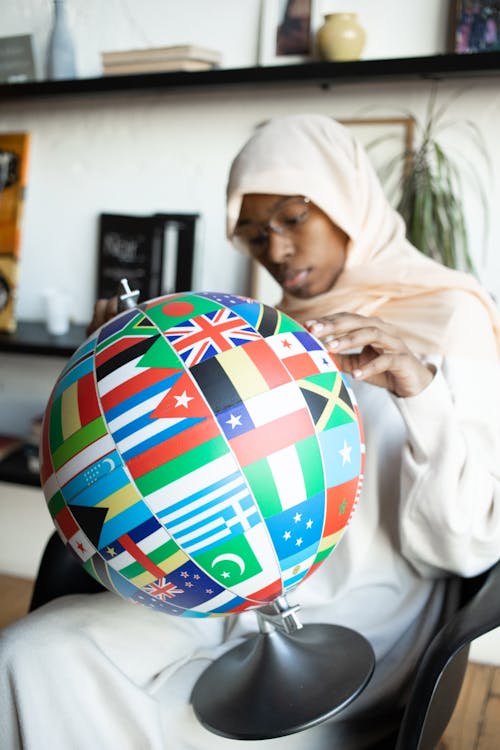Arabic Level 1, Activity 09: “البُلدَان والجِنسِيّات / Countries & Nationalities” (Face-to-Face/Online)

Description:
In this activity, students will be learning about Arabic countries in addition to European and South American countries. Also, practice asking and answering questions about various nationalities. Using feminine and masculine forms.
Semantic Topics:
مصر – مصري – مصرية – الأردن – أردني – أردنية – السعودية – سعودي – سعودية – أمريكا – أمريكي – أمريكية، الجنسيات، البلدان، جنسيتي، انا من، countries، nationalities، I’m from
Grammatical Structures:
feminine and masculine forms
Products: Varieties of the Arabic world, a slide showing the differences in middle-eastern dialects of Arabic (see cultural notes)
Practices: Differentiating between Standard Arabic and other dialects of Arabic, understanding how to say my nationality in Arabic.
Perspectives: The importance of Modern Standard Arabic الفصحى.
- Standard 1.1: Students engage in conversations or correspondence in Arabic to provide and obtain information, express feelings and emotions, and exchange opinions.
- Standard 1.2: Students understand and interpret spoken and written Arabic on a variety of topics.
- Standard 4.1: Students demonstrate an understanding of the nature of language through comparisons of Arabic and their own languages.
Idaho Content Standards for World Languages:
- COMM 1.1: Interact and negotiate meaning (spoken, signed, written conversation) to share information, reactions, feelings, and opinions.
- COMM 2.1: Understand, interpret, and analyze what is heard, read, or viewed on a variety of topics.
- COMP 1.1: Observe formal and informal forms of language.
- COMP 1.2: Identify patterns and explain discrepancies in the sounds and the writing system in the target language.
NCSSFL-ACTFL Can-Do Statements:
- I can identify the names of Arabic countries.
- I can ask someone where they are from and say where am I from?
- I can use either feminine or masculine to describe my nationality.
Materials Needed:
Warm-Up
- Greet students in Arabic السلام عليكم and then share your screen with students and pull up the presentation. And don’t forget to press on Slideshow.
رحب بالطلاب باللغة العربية، السلام عليكم، ثم شارك شاشتك مع الطلاب واسحب العرض التقديمي. ولا تنس الضغط على زر العرض. - Move to the next slide with the “Can-Do Statements” and read each Can-Do statement in English.
انتقل إلى الشريحة التالية “عبارات Can-Do” واقرأ كل عبارة Can-Do باللغة الإنجليزية. - Next, move to the slide that represents the warm-up activity. Encourage students to read the names of Arabic countries from the map (in Arabic). If they cannot do it, you can read, and they repeat after you.
بعد ذلك ، انتقل إلى الشريحة التالية ، والتي تمثل نشاط الإحماء. شجع الطلاب على قراءة أسماء الدول العربية من الخريطة (باللغة العربية). إذا لم يتمكنوا من فعل ذلك ، يمكنك القراءة ، ويكررون بعدك. - Move to the next slide, and let students take turns reading the European countries.
انتقل إلى الشريحة التالية، ودع الطلاب يتناوبون على قراءة الدول الأوروبية.
Main Activity
- Ask students to choose an Arabic country flag and search about it on their phones.
اطلب من الطلاب اختيار علم دولة عربية والبحث عنها على هواتفهم. - In the form of conversation, students will ask each other these questions in Arabic, “where are you from? What is your nationality?” their answer will be according to the country they chose in the 1st place.
في شكل محادثة ، سيسأل الطلاب بعضهم البعض هذه الأسئلة باللغة العربية ، “من أين أنت؟ ما هيه جنسيتك؟” ستكون إجابتهم حسب الدولة التي اختاروها في المركز الأول. - Then, a student can choose one of his/her classmates to ask the questions, then the student who answered chooses another student and asks her/him the same questions.
بعد ذلك ، يمكن للطالب اختيار أحد زملائه في الفصل لطرح الأسئلة ، ثم يختار الطالب الذي أجاب طالبًا آخر ويطرح عليه الأسئلة نفسها. - Make sure that all students participate in asking and answering the questions.
تأكد من مشاركة جميع الطلاب في طرح الأسئلة والإجابة عليها. - Pull up slide #6, students can use them as an example of how they should answer these questions.
افتح الشريحة رقم 6 ، يمكن للطلاب استخدامها كمثال لكيفية الإجابة على هذه الأسئلة. - Show students that slide #7 is an example of European countries and nationalities.
أظهر للطلاب أن الشريحة رقم 7 هي أيضًا مثال على الدول والجنسيات الأوروبية.
Wrap-Up
- Read through the culture slide.
اقرأ شريحة الثقافة. - Ask students if they have any questions.
اسأل الطلاب عما إذا كانت لديهم أية أسئلة.
End of Activity
- Read through the culture slide.
- Read Can-Do statements once more and have students evaluate
their confidence.
(Use thumbs up/thumbs down or download our student cards.) - Encourage students to be honest in their self-evaluation.
- Pay attention, and try to use feedback for future activities!
NCSSFL-ACTFL Can-Do Statements:
- I can identify the names of Arabic countries.
- I can ask someone where they are from and say where am I from?
- I can use either feminine or masculine to describe my nationality.

